Medals Won by men of the Creekside Cluster [Appendix 1]
![]() This page brings into one place an account of medals awarded to casualties across the Kingsdown and Creekside Cluster of eight Parishes.
This page brings into one place an account of medals awarded to casualties across the Kingsdown and Creekside Cluster of eight Parishes.
In the popular post-war press, when the war medals were awarded they were given nick-names from contemporary cartoon characters found in the Daily Mirror newspaper at that time:-
(1) Most service-men were only awarded the British War and Victory Medals - when worn together they became known as "Mutt and Jeff";
(2) Those who served overseas at or near the outbreak of war would receive the 1914 or 1914-15 Star, the British War Medal and the Victory Medal - when worn together they became known as "Pip, Squeak, and Wilfred" (a dog, a penguin and a rabbit).
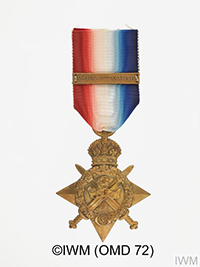 |
The 1914 Star (a.k.a. Mons Star) The medal is made of bronze with a red, white and blue ribbon, reflecting the French Tricolour. To be eligible you had to be a member of the British Forces who had served in France or Belgium between 5 August 1914 (the declaration of war) and midnight 22 November 1914 (the end of the First Battle of Ypres). Predominantly those eligible would have been the 'Old Contemptibles', the professional pre-war soldiers of the British Expeditionary Force. The medal would be adorned with a horizontal metal bar worn on the ribbon and inscribed '5th Aug.-22nd Nov. 1914'. To be eligible you would have served under enemy fire. The service number, rank, name and unit were impressed on the back. |
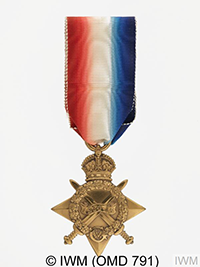 |
The 1914-15 star Similar to the 1914 Star but with the dates 1914-15 in the centre of the star, it was issued to a wider range of recipients. They included those who served in any theatre of war outside the UK between 5 August 1914 and 31 December 1915, except those eligible for the 1914 Star. The recipient's service number, rank, name and unit were impressed on the reverse. These two "star" medals were never awarded alone. The recipient would also receive the British War Medal and the Victory Medal. These three medals together were nicknamed "Pip, Squeak and Wilfred". They were characters in a Daily Mirror comic strip that featured Pip the dog, Squeak the penguin and Wilfred the rabbit. |
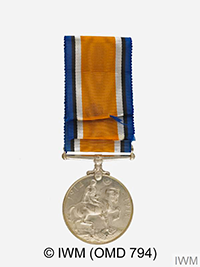 |
British War Medal 1914-18 This solid silver medal was awarded to officers and men of the British and Imperial Forces who either entered a theatre of war (an area of active fighting) or served overseas (perhaps as a garrison soldier) between 5 August 1914 and 11 November 1918 inclusive. Later this was extended to service in Russia, Siberia and some other areas in 1919 and 1920. The front depicts King George V and the reverse shows the dates of the First World War and St. George on horseback trampling underfoot the eagle shield of the central powers (German and Austro-Hungarian Empires), with a skull and cross-bones. The ribbon has a central band of orange edged with white, black and blue lines. The recipient's service number, rank, name and unit were inscribed on the rim of the medal. This is the only medal that could be awarded on its own. Sadly a lot of these medals were sold for scrap value. |
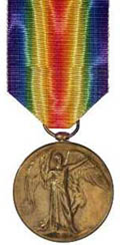 |
The Victory Medal 1914-18 Made of bronze, a serviceman would have to have entered a theatre of war (an area of active fighting), not just served overseas, to qualify for this medal. The face of the medal has a depiction of the winged figure of Victory and on the reverse it says 'The Great War for Civilisation 1914-1919'. Their service number, rank, name and unit were impressed on the rim. The colours of the ribbon represent the combined colours of the Allied nations, with the rainbow additionally representing the calm after the storm. The ribbon consists of a double rainbow with red at the centre. This medal would always be awarded along with the British War Medal. The British War Medal and the Victory medal worn together were nicknamed "Mutt and Jeff" after two American comic strip characters. |
|
The Territorial Force War Medal Circular bronze medal. The ribbon is yellow with two narrow inner vertical stripes of dark green. The medal was designed by Sir Bertram MacKennal, whose initials appear at the base of the Royal effigy. It was awarded to all members of the Territorial Force, including Nursing Sisters, who were members of the service on 4 August 1914, and to those who had completed four years' service before 4 August 1914, providing they had rejoined on, or prior to, 30 September 1914. In addition to the above, to be eligible for the award members must have: (a) undertaken on or before 30 September 1914 to serve outside the United Kingdom; (b) served outside the United Kingdom between 4 August 1914 and midnight 11/12 November 1918; (c) be ineligible for either the 1914 or 1914-15 Star. The medal is worn immediately after the Victory Medal and before all subsequently awarded war medals. It is the rarest of the five British Great War medals. Our only casualty to receive this award was Bandsman, Thomas Goodwin of Oare |
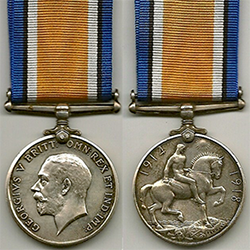 |
Military Medal (M.M.) The Military Medal was awarded to other ranks of the British Army and Commonwealth Forces. It was an award for gallantry and devotion to duty when under fire in battle on land. The reverse of the medal is inscribed "For Bravery in the Field". The recipient's details are inscribed around the edge. The ribbon is dark blue, with five equal centre stripes in order white, red, white, red, and white. The recipient is entitled to use the letters M.M. after their name. Two casualties from the Creekside Ecclesiastical Parish were awarded this medal: Herbert David Gambell - Lynsted Alfred Henry Feaver - Teynham |
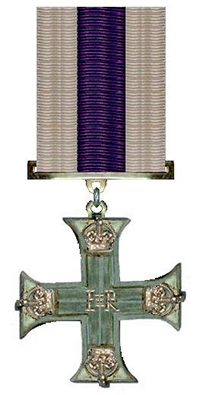 |
Military Cross (M.C.) Instituted by Royal Warrant on 28th December 1914. Made of silver, the Military Cross was a decoration for gallantry during active operations in the presence of the enemy. Issued to British Army, Indian Army or Colonial Forces commissioned officers with the rank of Captain or below or Warrant Officers. From June 1917, officers of the rank of Captain but who had a temporary rank of Major could receive the award. The reverse of the medal was issued plain with no engraving. Some families and individuals engraved their details at their own expense. The ribbon width is 32mm and consists of three equal vertical moiré stripes of white, purple, and white. Recipients of the medal are entitled to use the letters M.C. after their name. |
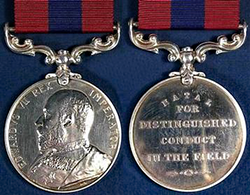 |
The Distinguished Conduct Medal (DCM) Awarded for extremely high levels of bravery, the DCM was instituted during the Crimean War in 1854, it was awarded to other ranks who had shown the equivalent level of bravery that led to commissioned officers qualifying for the Distinguished Service Order. However, the DCM ranked well below the DSO in precedence. Any further acts of bravery would be recognised with the addition of bars, but this was changed to laurel wreaths in 1916. Recipients are entitled to the post-nominal letters DCM. A silver medal 36 mm in diameter. The obverse of this medal is an effigy of the reigning monarch. The reverse on all issues bears the inscription "FOR DISTINGUISHED CONDUCT IN THE FIELD". The suspender is of an ornate scroll type. The ribbon is 32 mm wide, with three equal parts crimson, dark blue, and crimson. |
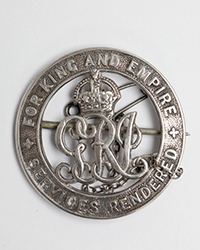 |
The Silver War Badge This sterling silver lapel badge intended to be worn on the right breast on civilian clothes only, was issued to UK WW1 service personnel who had been honourably discharged due to wounds or sickness. It was also referred to as a Discharge Badge, Wound Badge or Services Rendered Badge. It was first issued in September 1916, accompanied by an official certificate of entitlement. This was put in place to avoid the ex-serviceman being subjected to the pactice of some women to present white feathers to apparently ablebodied young men who were not wearing the King's uniform. Each badge held a unique number on the reverse. |
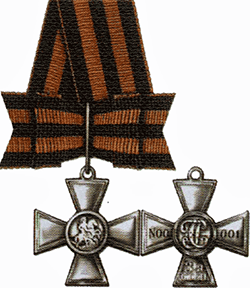 |
 The Medal of St. George, Third Class The only recipient of this Russian honour was Teynham man and submariner Thomas Baker. Died 24th February 1917. It was intended as a reward for "undaunted courage" by the lower ranks (soldiers, sailors and NCOs) of the military. The Medal of St. George, Third Class The only recipient of this Russian honour was Teynham man and submariner Thomas Baker. Died 24th February 1917. It was intended as a reward for "undaunted courage" by the lower ranks (soldiers, sailors and NCOs) of the military. |

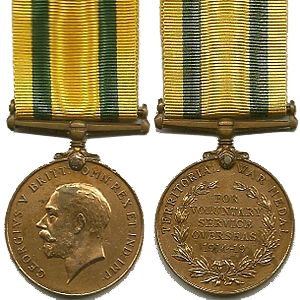
 World War 1 Pages
World War 1 Pages